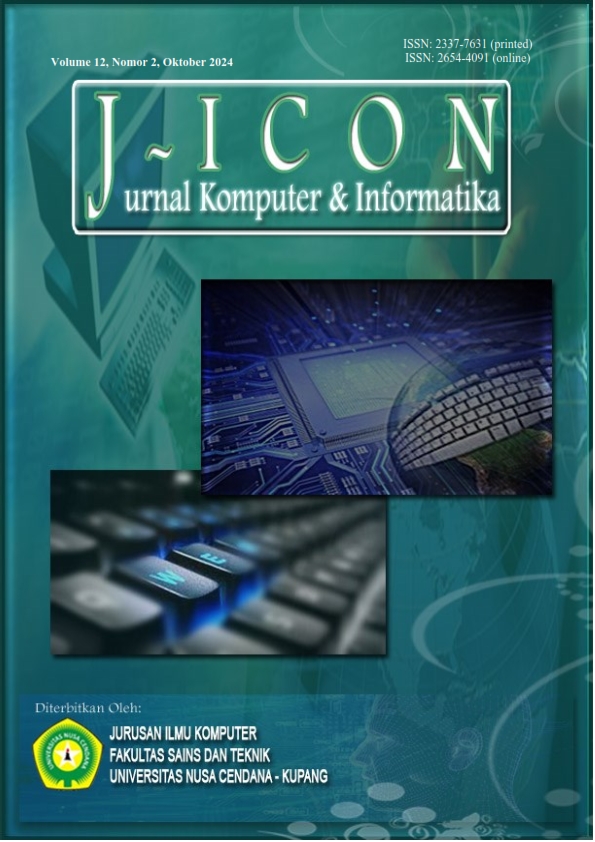RICE QUALITY CLASSIFICATION USING ANDROID-BASED CONVOLUTIONAL NEURAL NETWORK
Abstract
The importance of rice as a food commodity in Asia, especially in Indonesia, lies not only in its role as a major source of carbohydrates, but also in its quality that affects the selling value, nutritional aspects, and consumer satisfaction. In this context, research on rice quality becomes essential, with an emphasis on shape and color as the main factors affecting rice quality. Rice that is whiter, cleaner, and intact tends to have better quality, making the assessment of the level of whiteness and cleanliness of rice crucial in the food industry. To evaluate rice quality, this study utilizes Deep Learning technology with a focus on developing an Android application. The model used is the Convolutional Neural Network (CNN) with VGG-16 architecture. The application of the Extreme Programming development method in creating this application shows an adaptive and responsive approach to changing user needs. In essence, this application aims to provide a smart and efficient solution in classifying rice quality based on its physical characteristics. Through rice image analysis, the application can assess the level of whiteness and cleanliness, while the area analysis of the rice object is used to evaluate the level of integrity. Thus, this application is expected to be a tool that can help food industry players, farmers, and consumers in assessing and selecting rice that meets the desired quality standards. This research opens up opportunities to improve understanding related to rice quality evaluation by utilizing advances in Deep Learning technology.
Downloads
References
M. Rais Wathani and N. Hidayati, “Analisis Perbandingan Fungsi Aktivasi CNN PadaPengelompokan Jenis Beras Berdasarkan Mutu Beras,” BRAHMANA J. Penerapan Kecerdasan Buatan, vol. 4, no. 2, pp. 144–153, 2023.
MUHAMMAD ZAINAL ALTIM, ABDULLAH BASALAMAH, KASMAN, RITA AMALIA SYAMSUL, and ANDI YUDHISTIRA, “Implementasi Convolutional neural network (CNN) Untuk Penentuan Kualitas Beras Berdasarkan Bentuk Dan Warna,” J. INSTEK (Informatika Sains dan Teknol., vol. 8, no. 2, pp. 380–386, 2023, doi: 10.24252/instek.v8i2.42968.
F. Paramudita and M. I. Zulfa, “Aplikasi Android Pendeteksi Kualitas Beras Berbasis Machine Learning Menggunakan Metode Convolutional neural network,” J. Pendidik. dan Teknol. Indones., vol. 3, no. 7, pp. 297–305, 2023, doi: 10.52436/1.jpti.310.
V. A. A. Pellokila, K. Usman, and N. K. C. Pratiwi, “Pemanfaatan Convolutional neural network (CNN) Untuk Klasifikasi Jenis Beras Berbasis Citra,” vol. 10, no. 5, pp. 4246–4252, 2023.
Weny Indah Kusumawati and Adisaputra Zidha Noorizki, “Perbandingan Performa Algoritma VGG16 Dan VGG19 Melalui Metode CNN Untuk Klasifikasi Varietas Beras,” J. Comput. Electron. Telecommun., vol. 4, no. 2, 2023, doi: 10.52435/complete.v4i2.387.
A. M. Lesmana, R. P. Fadhillah, and C. Rozikin, “Identifikasi Penyakit pada Citra Daun Kentang Menggunakan Convolutional neural network (CNN),” J. Sains dan Inform., vol. 8, no. 1, pp. 21–30, 2022, doi: 10.34128/jsi.v8i1.377.
B. Julianto, I. N. Farida, and M. A. D. W. Dara, “Implementasi Metode CNN Pada Aplikasi Android Untuk Deteksi Penyakit Pada Daun Padi Penulis Korespondensi,” Inotek, vol. 7, pp. 2549–7952, 2023, [Online]. Available: https://proceeding.unpkediri.ac.id/index.php/inotek/
L. Arisandi and B. Satya, “Sistem Klarifikasi Bahasa Isyarat Indonesia (Bisindo) Dengan Menggunakan Algoritma Convolutional neural network,” J. Sist. Cerdas, vol. 5, no. 3, pp. 135–146, 2022, doi: 10.37396/jsc.v5i3.262.
R. P. Pratama, R. Hidayat, N. F. Fano, A. Akbar, and N. A. Rakhmawati, “Implementasi Deep Learning untuk Entity Matching pada Dataset Obat (Studi Kasus K24 dan Farmaku),” JISKA (Jurnal Inform. Sunan Kalijaga), vol. 6, no. 3, pp. 130–138, 2021, doi: 10.14421/jiska.2021.6.3.130-138.
Arolina Rinardi and Vita Amalia Herlinda, “Implementasi Model Convolutional neural network Untuk Klasifikasi Daun Sirih Dan Daun Pandan,” J. RESTI (Rekayasa Sist. dan Teknol. Informasi), vol. 6, pp. 2–6, 2022, [Online]. Available: https://doi.org/10.29207/resti.v6iX.xxx
Elinda Lusyana Puji Ristanti, “Analisis Dan Perbandingan Arsitektur VGG16 Dan Mobilenetv2 Untuk Klasifikasi Dan Identifikasi Penyakit Daun Pada Tanaman Cabai Menggunakan CNN,” J. Ilm. Sain dan Teknol., vol. 2, no. 9, pp. 216–226, 2024.
M. D. Meitantya, C. A. Sari, E. H. Rachmawanto, R. R. Ali, and U. D. Nuswantoro, “VGG16 ARCHITECTURE ON CNN FOR AMERICAN SIGN LANGUAGE,” vol. 5, no. 4, pp. 1165–1171, 2024.
M. Defriani and I. J. Jaelani, “Recognition of Regional Traditional House in Indonesia Using Convolutional neural network (CNN) Method,” J. Comput. Networks, Archit. High Perform. Comput., vol. 4, no. 2, pp. 104–115, 2022, doi: 10.47709/cnahpc.v4i2.1562.
M. A. Hasan, Y. Riyanto, and D. Riana, “Grape leaf image disease classification using CNN-VGG16 model,” J. Teknol. dan Sist. Komput., vol. 9, no. 4, pp. 218–223, 2021, doi: 10.14710/jtsiskom.2021.14013.
I. Ahmad, R. I. Borman, J. Fakhrurozi, and G. G. Caksana, “Software Development Dengan Extreme Programming (XP) Pada Aplikasi Deteksi Kemiripan Judul Skripsi Berbasis Android,” INOVTEK Polbeng - Seri Inform., vol. 5, no. 2, p. 297, 2020, doi: 10.35314/isi.v5i2.1654.
Copyright (c) 2024 Muhammad Yusuf, Reinhard Ruimassa, Anisa Iriani Tawainella, Devi Maharani

This work is licensed under a Creative Commons Attribution 4.0 International License.
The author submitting the manuscript must understand and agree that if accepted for publication, authors retain copyright and grant the journal right of first publication with the work simultaneously licensed under a Creative Commons Attribution (CC-BY) 4.0 License that allows others to share the work with an acknowledgment of the work’s authorship and initial publication in this journal.
 Muhammad Yusuf(1)
Muhammad Yusuf(1)




